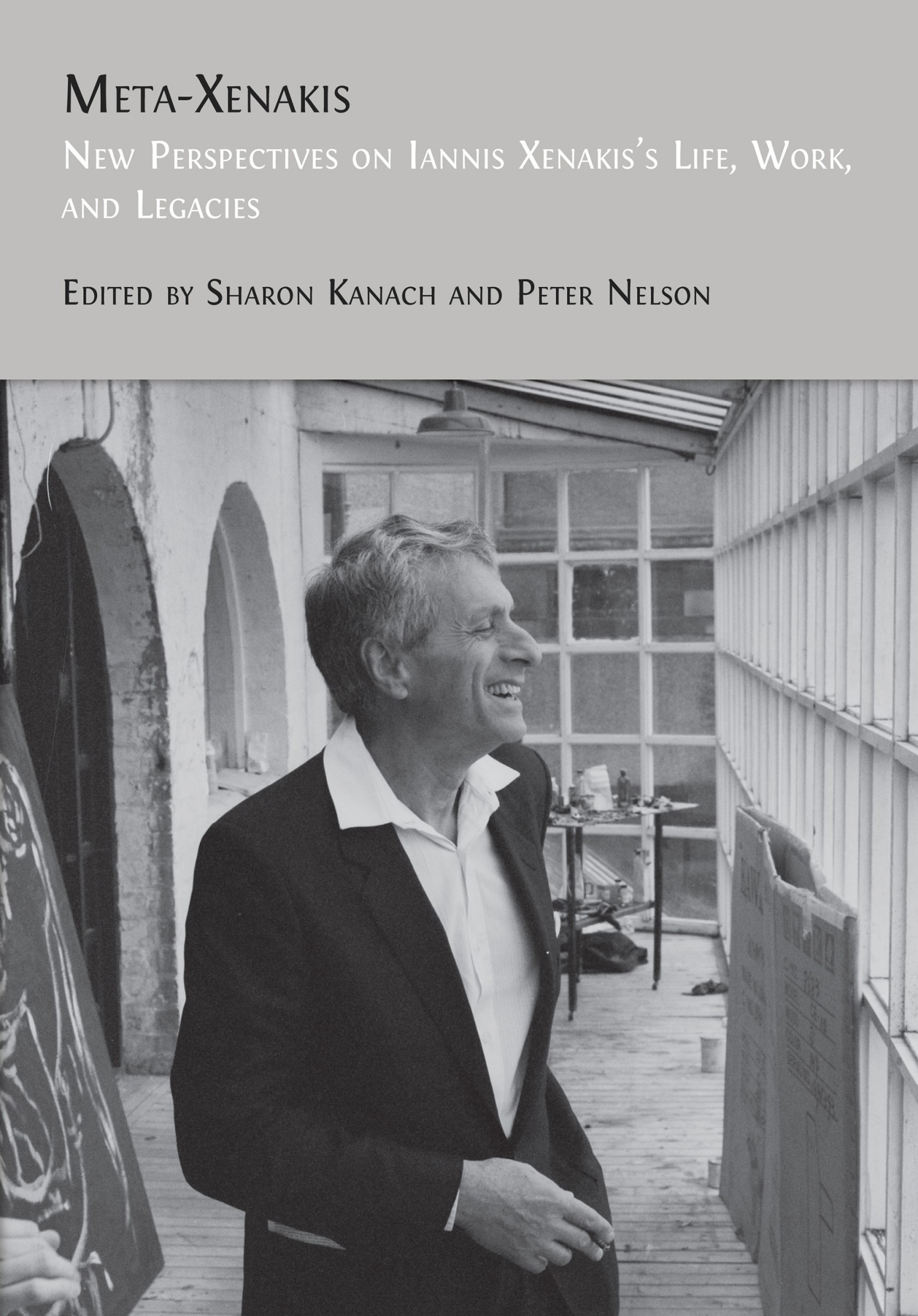34. Light Tectonics: The New Aesthetics in Iannis Xenakis’s Work
Yin Yu and Conrad Harris1
© 2024 Yin Yu and Conrad Harris, CC BY-NC 4.0 https://doi.org/10.11647/OBP.0390.36
The Encounter between Xenakis’s Work and his Students
I (Yin Yu) studied for a Master’s degree in Interior Architecture at the University of Oregon with a background in electronic engineering and information technology. I was very motivated by an interdisciplinary approach to architectural design. Around the early 2010s, open-source hardware became affordable. It instantly grabbed my attention and motivated me to experiment with new technologies in interior design projects. My Master’s dissertation, “Open-Source Community,” was deeply influenced by this software movement.2 After architecture school, I returned to China and started practicing in architectural design firms in Beijing. During my spare time, I built an open-source 3D printer at home and experimented with digital design and fabrication.
While in architecture school, I became aware of a Beijing-based musician and poet, Yan Jun (b. 1973), who works with field recordings of building sounds. I listened to “One” from the debut album, Ceremony (2012), by the Tea Rockers Quintet, which comprises Yan Jun, folk artist Xiao He, Guqin master Wu Na, multi-instrumentalist Li Daiguo, and tea master Lao Gu.3 The electronic sounds entwining traditional Chinese instruments and culture amazed me. Yan Jun created the Subjam label and organized a series of indie concerts called Miji. I met Yan Jun on 12 May 2015, during a Miji concert at the Meridian Space in Beijing. It was, of course, not a commercial concert. Only five people were in the audience (Beijing has a population of twenty-one million). After introducing myself as an architectural designer, Yan Jun mentioned a name that changed my life: Iannis Xenakis. Although I studied many works of Le Corbusier (1887–1965), Xenakis was not on my radar, nor was he for my architectural colleagues or teachers. Half a year later, to thank Yan Jun, I designed a 3D-printed object of his label Subjam (Figure 34.1), inspired by Xenakis’s Polytope de Montréal (1967).4
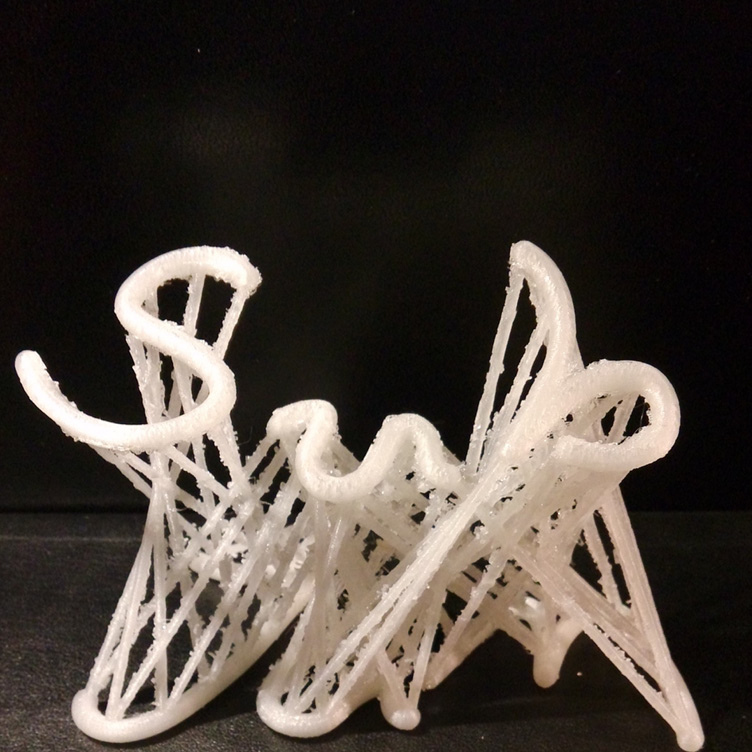
Fig. 34.1 The 3D-printed design for the music label Subjam (2015). Photo by Yin Yu.
Through the book Music and Architecture and the publication Iannis Xenakis: Architect, Composer, Visionary, Xenakis’s work immediately resonated with me.5 His theory and vision, and his works across art, architecture, music, and mathematics motivated me to do research and practice with new technologies.
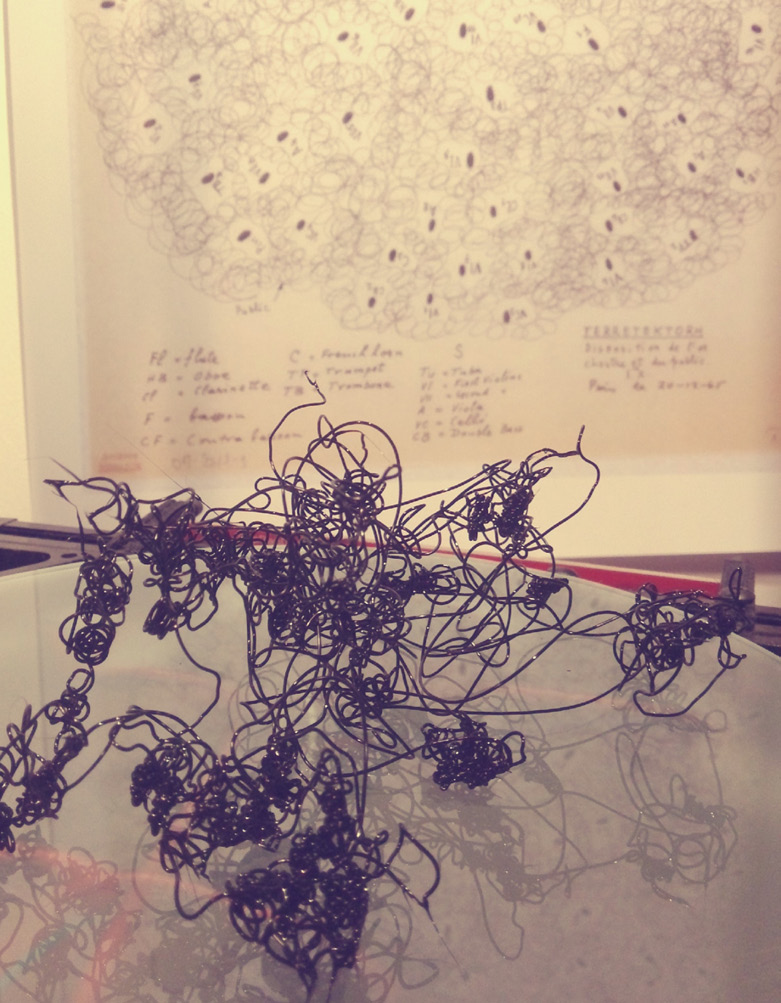
Fig. 34.2 An unexpected 3D-printed black object, in front of Xenakis’s drawing of Terretektorh (distribution of musicians) (2015). Photo by Yin Yu.
I started studying Xenakis’s work and began a few design experiments with a hobby 3D printer at home. An unexpected printing result (Figure 34.2) made me wonder how computers create “stochastic fabrication.” Soon, I realized that my independent research was extremely limited by the resources I could access. I started to consider a research path that focused on architecture and technology. However, I needed to figure out which program or institute to pursue it in. I reached out to Sharon Kanach (b. 1957) for advice on my career in 2016 (see below). Kanach, who later became one of my mentors, introduced me to Xenakis’s student, Curtis Roads (b. 1951), and the graduate program in Media Arts and Technology (MAT) at the University of California, Santa Barbara (UCSB). MAT has a strong interdisciplinary research culture. In addition, the program has the expertise and facilities in electronic music, which perfectly matched my desired research direction. After leaving Silicon Valley in 2010 as an engineer, I never thought I would return to California for art.
My PhD studies started in Fall 2017.6 I completed my dissertation, “Sound Morphogenesis: A Theory and Methodology of Architecture and Design informed by Sound and Music”7 in 2022.
My first encounter with Xenakis’s friends and students was actually before my doctoral study. In the summer of 2016, the Centre Iannis Xenakis (CIX) organized an international conference: From Xenakis to the Present: the Continuum in Music and Architecture.8 The first leg of this conference took place in Cyprus at the European University of Cyprus (Cultural Studies and Contemporary Arts research laboratory (CSCA)) and University of Cyprus (Architecture Department). During the two-day event, I met Sharon Kanach, co-director of CIX; David Lieberman (b. 1951), then a professor from The Daniels Faculty of Architecture, Landscape, and Design at the University of Toronto; Lori Freedman (b. 1958), a clarinettist, improviser, and composer; among many other inspiring musicians, architects, scholars, and Xenakis experts.
Another significant impact during the Continuum conference trip was the border crossing experience in Nicosia—a divided capital city in two countries (the Turkish side being only recognized by the Turkish state, the Cypriot side being a member of the European Union). Coming from China, I have experienced the digital border’s (the Great Firewall of China) disregard for human rights. Xenakis, a Greek political refugee who settled in France, inspires me from his work and life.
Xenakis’s Works Involving Light
My understanding of architecture evolved through researching Xenakis’s work and field studies. In December 2015, I hoped to see some of Xenakis’s drawings at the Centre de Documentation de la Musique Contemporaine (CDMC, Documentation Center for Contemporary Music). I did not find his drawings; however, some books collected in the library (Figure 34.3) at the CDMC became my first source. As an independent researcher who was outside of academia at that time, accessing this public library became extremely valuable. In May 2016, I visited several iconic buildings in France by Le Corbusier: Cité radieuse/Unité d’Habitation (Radiant City/Housing Project) in Marseille, the church Notre-Dame du Haut in Ronchamp, and the exterior of La Tourette convent outside of Lyon (Figure 34.4). I appreciated the aesthetics of these buildings more after learning that Xenakis designed or influenced some of their architectural elements. In March 2019, I visited the Roman baths’ Frigidarium at the Musée de Cluny in Paris, where Xenakis showcased his Polytope de Cluny between 1972–4. Curtis Roads shared with me that he experienced this twenty-seven-minute sound and light performance eight times! Xenakis’s Polytope de Cluny marked this ancient Roman architecture with special memories for people who had attended the performances. The Frigidarium, however, was dark and quiet during my visit (Figure 34.5). It left a sense of emptiness, but also motivated me to reimagine the Frigidarium as a legacy venue for future performances. My last field study before the COVID-19 pandemic took place in September 2019. I drove to the archaeological site at Mycenae, where Xenakis’s Polytope de Mycènes took place in 1978. The thirty-two-hectare site overwhelmed me with its massive scale.
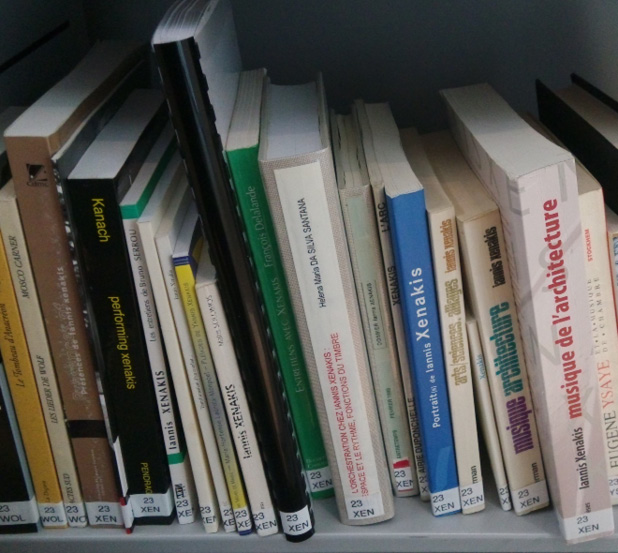
Fig. 34.3 A section of the book collection about Iannis Xenakis at the Centre de Documentation de Musique Contemporaine (CDMC), Paris (2015). Photo by Yin Yu.
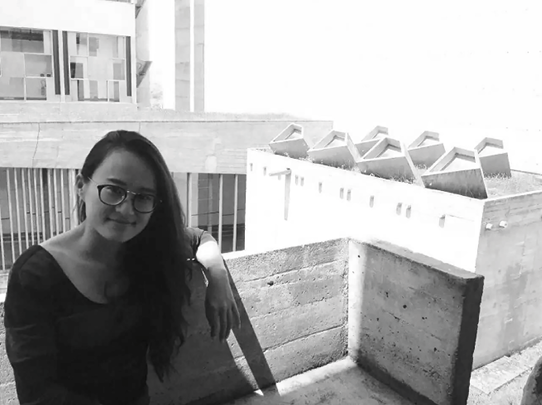
Fig. 34.4 The author at the entrance of La Tourette with Xenakis’s design of light “machine guns” behind her (2016). Photo by Yuanming Hu.
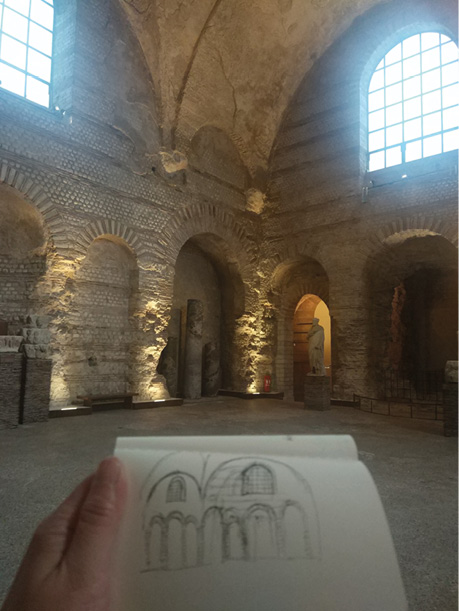
Fig. 34.5 A personal sketch in the Roman baths’ Frigidarium at the Musée de Cluny (2019). Photo by Yin Yu.
At MAT, my research explored Xenakis’s work through various media, such as virtual reality (VR), laser light performance, audio-activated digital architecture, and audio/visual performance. In 2018, I created a VR piece called Polytope de Giza (Figure 34.6) which virtually represents a light composition at the Great Pyramid in Egypt. The virtual location of the project was inspired by Xenakis’s drawing of Cosmic City (1964), where the scale is much larger than Giza.9 The sound playback speed in the VR is based on the user’s walking speed.10 I was able to experience the change of sound speed through a virtual walkthrough.
In 2019, I did my first laser performance. Inspired by the hanging “mathematical object” both inside and outside of the Philips Pavilion, Laser Architecture was a light and sound performance converting digital Platonic solid geometry into sound waves and laser vectors (Figure 34.7). As I was not formally trained as a performer, this public performance was an encouraging steppingstone.
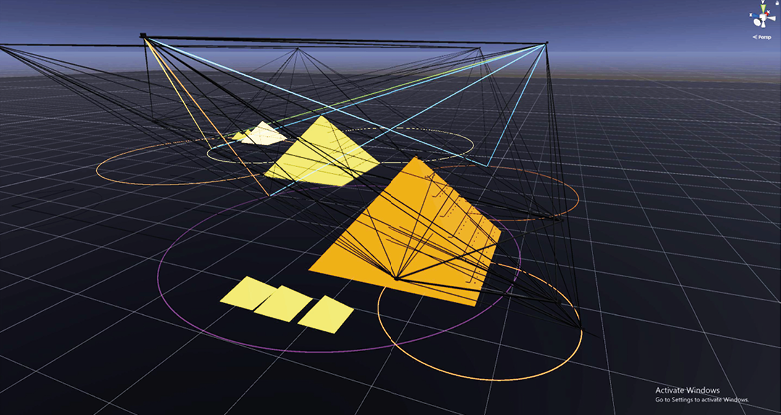
Fig. 34.6 A screen capture of the Polytope de Giza (2018). Figure created by Yin Yu.
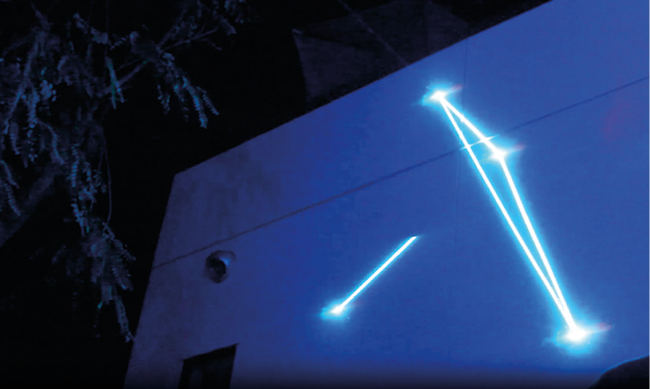
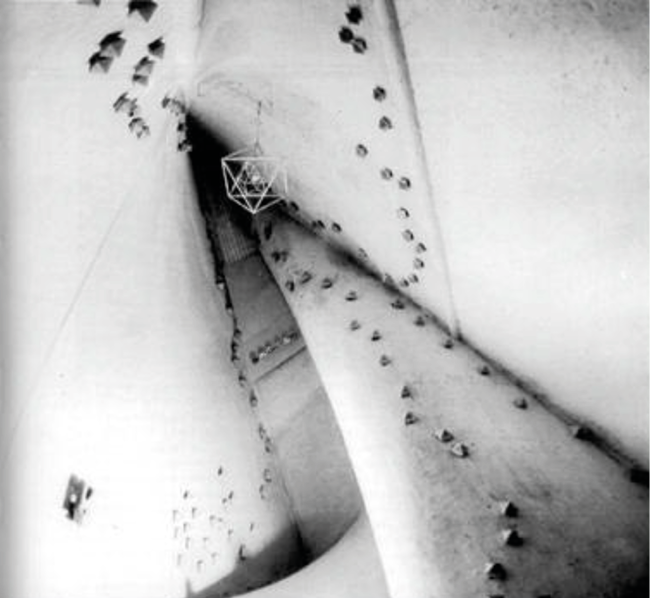
Fig. 34.7 (a) The performance of Laser Architecture at the Santa Barbara Center for Art, Science and Technology, March 2019 (Photo by Sihwa Park).11 (b) The Platonic mathematical object hanging on the ceiling of the Philips Pavilion. © F.L.C./ADAGP, Paris/Artists Rights Society (ARS), New York, 2024.
Light as the Bridge Between Music and Architecture
After visiting some architecture sites, and practicing as a multimedia artist and architectural designer, I came to the realization that light is the bridge between Xenakis’s music and his architectural work. Not only artificial light in his polytopes, but also natural light in his architectural work. Light manifests form in architecture through direct and indirect lighting; light embodies time in music via period and frequency of lighting. Light connects Xenakis’s two vocations: architecture and music.
One can trace Xenakis’s light work back to the 1950s when he worked at Le Corbusier’s studio. From his early study on light and the calculation of a sun path for the Assembly Building in Chandigarh, then “light canons,” “machine guns” in the chapel of La Tourette, to the “streetlight” at the Unité d’Habitation in Marseille, as well as his famous and ubiquitous “undulating glass panes.”12 From the 1960s, Xenakis’s light work expanded to computer-controlled artificial light, such as the flashing lights in Polytope de Montréal, laser lights in the Polytope de Cluny, and so on.13 Light, in Xenakis’s oeuvre, is a material that creates space, generates patterns, changes colors, evolves forms, and composes movement.14
Light Tectonics: Points, Lines, and Vectors
To celebrate Xenakis’s centenary, in 2022, the Xenakis Project of the Americas commissioned Conrad Harris and me to collaborate on a piece we titled The Shape of Light: A Visual Composition for Xenakis’s Mikka and Mikka S.15 It is a performance of solo violin and audio visualization of Iannis Xenakis’s composition Mikka (1971) and Mikka S (1976). The goal was to bring a new perspective on Xenakis’s music and architecture through light study and digital technology. I call this approach light tectonics, which describes Xenakis’s light phenomena. He used architectural elements, spatial location, computers, and light sources to compose visual performances in his work. The architectural elements include ceilings, walls, windows, and so on. For example, in the undulating glass panes, Xenakis designed a glazing system where light enters to create a performative space that changes throughout the day. Spatial location is the relative location of light. For instance, in the Polytope de Cluny, each laser beam was placed on a scaffold at a specifically designated location. In the Polytope de Mycènes, torches were carried around paths on the archaeological site.
Computers were used in many of Xenakis’s polytopes. For example, in the Polytope de Montréal, Xenakis used computers to control the sequencing of the flashing lights. Like ingredients to a chef, Xenakis combined a variety of light sources in his work, such as direct/indirect light, flashing lights, searchlights, etc. In The Shape of Light, I selected six light tectonics “scenes” inspired by Xenakis’s work.
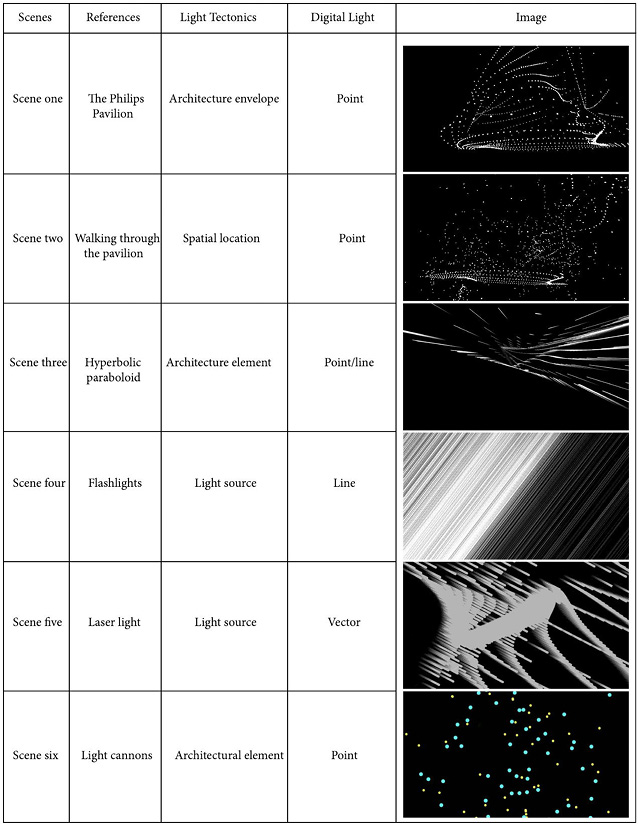
Table 34.1 A table of light tectonics in The Shape of Light.
The first scene is the iconic Xenakis structure—the building envelope of the Philips Pavilion. I transform the continuous surfaces of the Philips Pavilion’s digital model into a group of points. Each point represents a digital light source (e.g., LED light). Because of the density of the points, one can quickly identify the shape of the points based on the form of the Philips Pavilion. The second scene adds a spatial location element based on the first scene, bringing the viewers into the Pavilion. For the third scene, I focus more on detail. Since the hyperbolic paraboloid is an essential architectural element of the pavilion, a single surface of the Philips Pavilion was selected. I transform this single surface into light beams. In this scene, digital lines represent the light beams. The fourth scene is a light phenomenon that transitions from the lights in the hallway at La Tourette to the flashing lights of the Polytope de Montréal. Continuing to the fifth scene, inspired by Xenakis’s light trajectory design for laser beams and searchlights in his later works, vectors were used to represent light directions. Finally, the sixth scene highlights the “light cannons” at La Tourette and Xenakis’s passion for cosmology. The colored circles represent the white, red, and black “light canons” at La Tourette. The circles then transform into many small dots that represent stars in the sky. Table 34.1 summarizes the content of each of the six scenes, the design decision, the form of the digital light, and the image visualization.
During our collaboration, Harris stated that Metastasis (1953–4) “gave birth” to the Philips Pavilion. The selection of these six scenes focuses on digital light transformations based on the form of the iconic structure, coupled with the live solo violin performance of Mikka and Mikka S. Harris’s performance of the glissandi makes the digital light transformation represent a new aesthetic of Xenakis’s work.
The Shape of Light: A Visual Composition for Xenakis’s Mikka and Mikka S
There are two versions of The Shape of Light (Media 34.1 and 34.2) performance. The first version was a pre-recorded performance for online screening, premiered on Xenakis’s 100th birthday (29 May 2022) through the Meta-Xenakis consortium’s website.16 The second version was a live performance that premiered on 30 September 2022 at the Graduate Center of the City University of New York (CUNY) during the USA leg of the Meta-Xenakis Global Symposium Marathon. The pre-recorded version was also shown during coffee breaks in all five venues of the Marathon (Rouen (France), New York, Nagoya (Japan), Athens (Greece), and Mexico City (Mexico)).
The first version of the Shape of Light contains eight minutes of unedited live music recording and audiovisual composition. Harris’s article on Mikka and Mikka S in Xenakis Matters is insightful and inspiring, along with his numerous performances of the work.17 We wanted to take this opportunity to reenact a live performance by Harris with a visual representation that I would produce. Since it was for an online event, we decided that a pre-recorded video would be the best way to show the work. I recorded Harris’s live performance on 20 April at the Karl Geiringer Hall UCSB, with assistance from sound engineer Connor Long. The black and white video intended to focus on the music and light. With a dark gray background, the white color represents light forms. The visual contains two layers. Harris’s performance is one layer—recorded by a static camera from one direction. The audio visualization is another layer—which was generated by the software TouchDesigner (see below), based on the music. The final result is an edited visual composition of these two layers combined with Harris’s unedited performance of the two works, back-to-back. Sound artist Juan Manuel Escalante (b. 1982) mastered the sound. Figure 34.8 illustrates three different moments from the video.
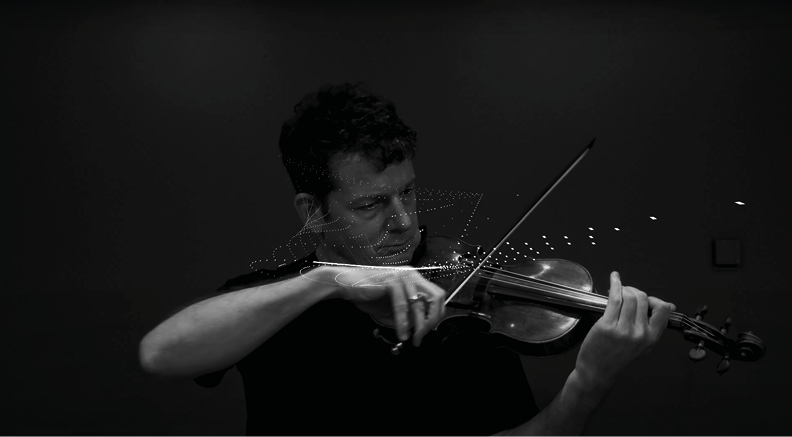


Fig. 34.8a–c Three scenes from version I of The Shape of Light video (2022). Figure created by Yin Yu.
The second version of The Shape of Light was a live performance in which Harris played solo violin, and I projected the visualization in real time. The live performance took place in the Skylight conference room sponsored by the Brook Center for Music Research and Documentation at the Graduate Center of CUNY in New York City during the USA tranche of Meta-Xenakis Global Symposium Marathon on 30 September 2022. Continuing from the first version, I brought in three additional visual elements for this live performance. They were inspired by Xenakis’s light work, including laser lights, flashing lights, and light cannons. While Harris was playing, the string sounds were captured by the computer’s microphone, which triggered the audiovisual software to project visual interpretations to two screen monitors (Figure 34.9). From a visual artist’s perspective, the challenge of the live performance was the time measure. I sketched a provisional performance score on a paper after a few rehearsals. Figure 34.10 is a digital version based on the original sketch.
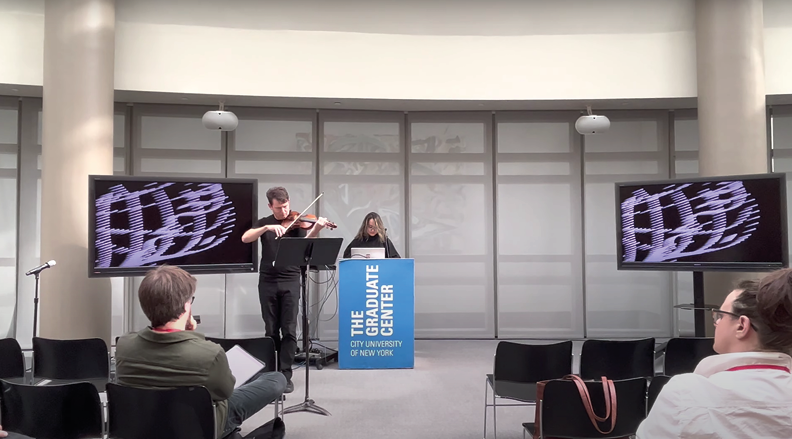
Fig. 34.9 Live performance of the Shape of Light (version II) at the Brook Center, CUNY (2022). Photo by Pauline Kim Harris.
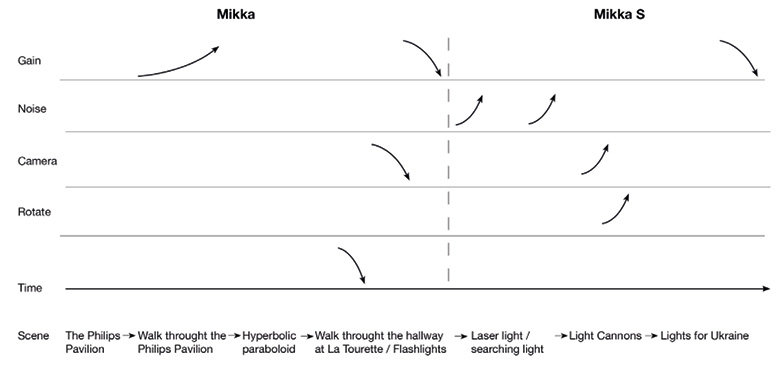
Fig. 34.10 A visual performance score for The Shape of Light (2022). Figure created by Yin Yu.
As Xenakis stated, “seen from the point of view of art, all of our knowledge and our actions are but aesthetic expressions of forms and their transformations.”18 The two versions of The Shape of Light echo this idea. They express light forms and reinterpretations of music into digital light visualizations.
System Interface and Detail Design
The project was realized using TouchDesigner (TD), a real-time, interactive, multimedia software. I developed a user interface (UI) for the live performance (Figure 34.11). On the right side is a list of manual controls, such as a scene switcher, gain controllers, and camera orientation. On the left is a real-time screen monitor. With this console, focusing on the sound and visuals is possible without entering each scene’s visual setting. The UI provides a critical tool for a live performance setting.
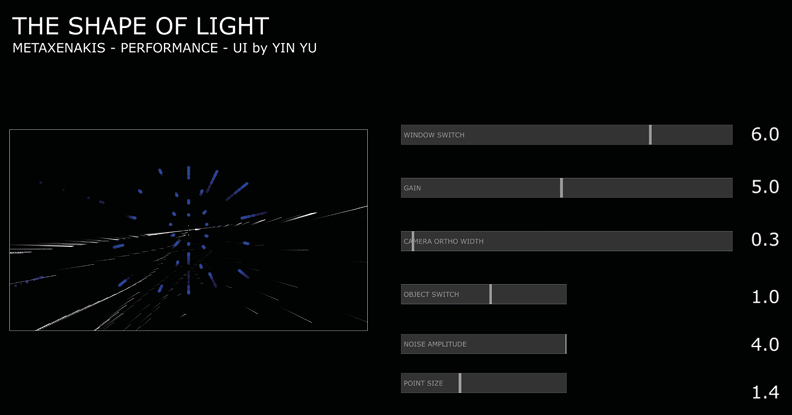
Fig. 34.11 The customized interface for the live performance of The Shape of Light (2022). Figure created by Yin Yu.
Seven TD networks were developed for the live performance. For example, Figure 34.12 gives an example of the hyperbolic paraboloid scene network. First, I built a surface of a hyperbolic paraboloid using a 3D modeling software. After importing the 3D model into TD, the TD network transformed the surface into a group of points, and then, to lines. Frequency range (Low pass f= 1000 Hz , High pass f= 2000 Hz , and Bandpass f= 1500 Hz), amplitude, and beat detection were integrated for the audio detections. After the first rehearsal for the live performance, Harris suggested incorporating colors for the visual design. As a result, the frequency range was mapped to the color range in the last two scenes.
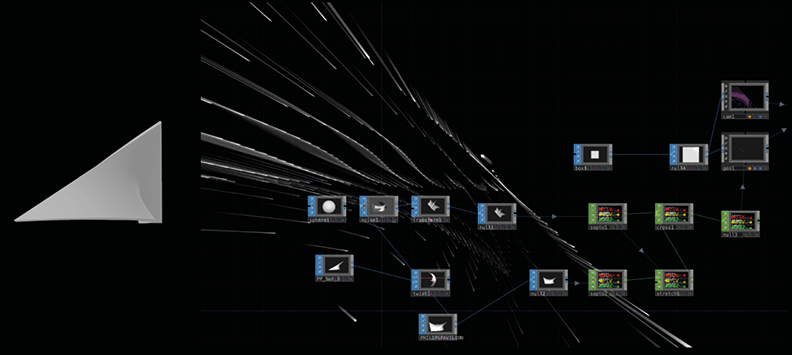
Fig. 34.12 The TouchDesigner network of hyperbolic paraboloid for audiovisual interpretation (2022). Figure created by Yin Yu.
Although Xenakis’s light did not directly inspire the last scene, I was motivated by Xenakis’s life from a political aspect. Questioning what I can do to respond to the 2022 Russian invasion of Ukraine, the scene of Lights for Ukraine (Figure 34.13) uses the blue and yellow colors as a support of Ukraine and reminds us of the ongoing wars in the world.
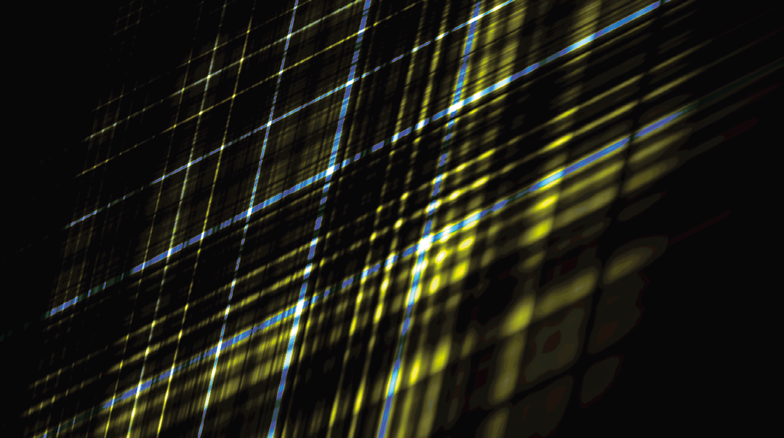
Fig. 34.13 The scene of Lights for Ukraine (2022). Figure created by Yin Yu.
Future Work
As mentioned above, the live performance of The Shape of Light premiered in the Skylight room at the Graduate Center of CUNY. As an audio-visual performance, we were limited by the acoustic properties of this room and the size of the presentation screens. Multi-cameras live projecting, large projector screens, and an immersive sound system could enhance the live performance experience. In the future, this project could develop into a multimedia installation or VR/AR piece. For each scene, I would like to overlap more elements and details in the design. Finally, with new lighting technologies, I would like to reimagine and produce new types of polytopes with multimedia software.
Media 34.1 (a) Live performance, The Shape of Light: Mikka (2022). Video by Pauline Kim Harris.https://hdl.handle.net/20.500.12434/17d4d981
Media 34.1 (b) Live performance, The Shape of Light: Mikka S (2022). Video by Pauline Kim Harris.
https://hdl.handle.net/20.500.12434/074be057
Conclusion
Light in Xenakis’s work is poetic, dramatic, emotional, and powerful. Xenakis not only created a new aesthetic of light art but also projected a future direction for the role of light in art at large, especially in transdisciplinary encounters. Xenakis’s aesthetic for light as an artistic medium connects music and architecture. With new digital technologies, we may rediscover Xenakis’s work, and pursue research on the many possibilities for the future of art and science as alloys.
Coda
I (Conrad Harris) was first introduced to the music of Xenakis in music school, when a composer I was taking a class from loaned me some recordings. I had not heard anything like it! Around the same time, I was taking a class in art and architecture. and chose, as my final project, to make a model of the Philips Pavilion. It was crudely constructed out of paper, wood, and glue. Needless to say, I did not save it, nor are there any photographs of it. Nevertheless, I found it fascinating how closely Xenakis’s piece Metastasis resembled the architecture of the Pavilion. It immediately gave me the impression of a different type of music, with its roots in the three-dimensional. Since then, I think of musical performances as filling a specific space, visualizing sound extending into all corners of the concert hall.
My approach to learning Mikka and Mikka S was a methodical one.19 It seemed necessary to begin this way before becoming free to focus on the music’s sonorities, subsequent overtones, and sound projection.
I began to imagine, when playing Xenakis’s music, the laser beams, flashes of light, etc., that he used to create his polytopes.
Working with multidisciplinary artist Yin Yu on The Shape of Light provided an opportunity to explore further the possibilities of performances. A listener can “see” the music being played in space.
Media 34.2 Pre-recorded performance, The Shape of Light (2022). Video by Yin Yu.
https://hdl.handle.net/20.500.12434/93785dfa
References
HARRIS, Conrad (2010), “Mikka and Mikka S,” in Sharon Kanach (ed.), Performing Xenakis, Hillsdale, New York, Pendragon, p. 245–8.
KANACH, Sharon (2012), Xenakis Matters: Contexts, Processes, Applications, Hillsdale, New York, Pendragon.
KANACH, Sharon and LOVELACE, Carey (eds.) (2010), Iannis Xenakis: Composer, Architect, Visionary, New York, The Drawing Center, https://issuu.com/drawingcenter/docs/drawingpapers88_xenakis
XENAKIS, Iannis (2008), Music and Architecture: Architectural Projects, Texts, and Realizations/by Iannis Xenakis, compilation, translation, and commentary by Sharon Kanach, Hillsdale, New York, Pendragon.
YU, Yin (2013), “ePlayground: An Open-source Community,” https://w2.mat.ucsb.edu/yinyu/doc/YinYu__EPLAYGROUND_Book.pdf
YU, Yin (2022a), “Sound Morphogenesis: A Theory and Methodology of Architecture and Design informed by Sound and Music,” doctoral dissertation, UC Santa Barbara, https://escholarship.org/uc/item/90d6r0vm
YU, Yin (2022b), “Towards a Morphogenesis: Light in Xenakis’s Work,” in Anastasia Georgaki and Makis Solomos (eds.), Centenary International Symposium: Xenakis, Athens, Spyridon Kostarakis, p. 202–15.
1 The authors wish to thank Sharon Kanach for her guidance and advice around The Shape of Light project initiated by the Xenakis Project of the Americas. We are thankful to Carey Lovelace and Barbara Dobbs Mackenzie for leading and organizing the New York session of the Meta-Xenakis Global Symposium. Special thanks to Pauline Kim Harris for her video documentations. We thank Juan Manuel Esclante for his feedback on user interface design. The performance trip was supported by the School of Art and Design at the San Diego State University.
2 Yu, 2013.
3 See EnT-T (label), “Tea Rockers Quintet – One” (17 April 2012), YouTube, https://www.youtube.com/watch?v=dOTSAbQEQyg. See also “The Tea Rockers Quintet,” Bandcamp, https://thetearockersquintet.bandcamp.com/
4 Xenakis’s drawing which inspired my object can be seen in: Kanach and Lovelace, 2010, p. 66.
5 Xenakis, 2008; Kanach and Lovelace, 2010.
6 I was advised by Curtis Roads (chair), Sharon Kanach, Jennifer Jacobs (UCSB professor, researcher in computational fabrication, b. 1984), and Yitang Zhang (UCSB professor, mathematician, b. 1955).
7 Yu, 2022a.
8 Continuum2016, https://continuum2016.wordpress.com/
9 Xenakis’s drawing of the “Cosmic City” can be seen in Kanach and Lovelace, 2010, p. 86–7.
10 For the soundtrack, I used an audio file I downloaded from the internet. A male voice read ancient Egyptian poetry in Arabic. Since the project’s virtual site is in Giza, I wanted to use local cultural sounds as the audio background. Back in 2018, I had just started to learn digital audio processing. Downloading an audio file and reworking it was one of my early experiments.
11 Yin Yu, “Laser Architecture” (19 March 2019),
https://w2.mat.ucsb.edu/yinyu/projects/LaserArchitecture.html12 Xenakis, 2008, Chapters 1.06 and 1.10; Chapters 1.14 and 1.16; p. 15; Chapters 1.11–1.13.
13 Xenakis, 2008, Chapters 4.03–4.06; Chapter 4.11.
14 Yu, 2022b.
15 “Xenakis Project of the Americas,” The Brook Center,
https://brookcenter.gc.cuny.edu/projects/xenakis-project-of-the-americas/16 Meta-Xenakis, www.meta-xenakis.org
17 Harris, 2010; Kanach, 2012; see Brian Sawicki, “Conrad Harris - Mikka and Mikka S - Xenakis Matters” (1 March 2013), YouTube, https://www.youtube.com/watch?v=gQ0qDmr8j1s. This live performance was filmed at The Drawing Center on 28 February 2013 at The Drawing Center, NYC, during a book launch of Kanach, 2012.
18 Xenakis, 2008, p. 271.
19 See Harris, 2010.
